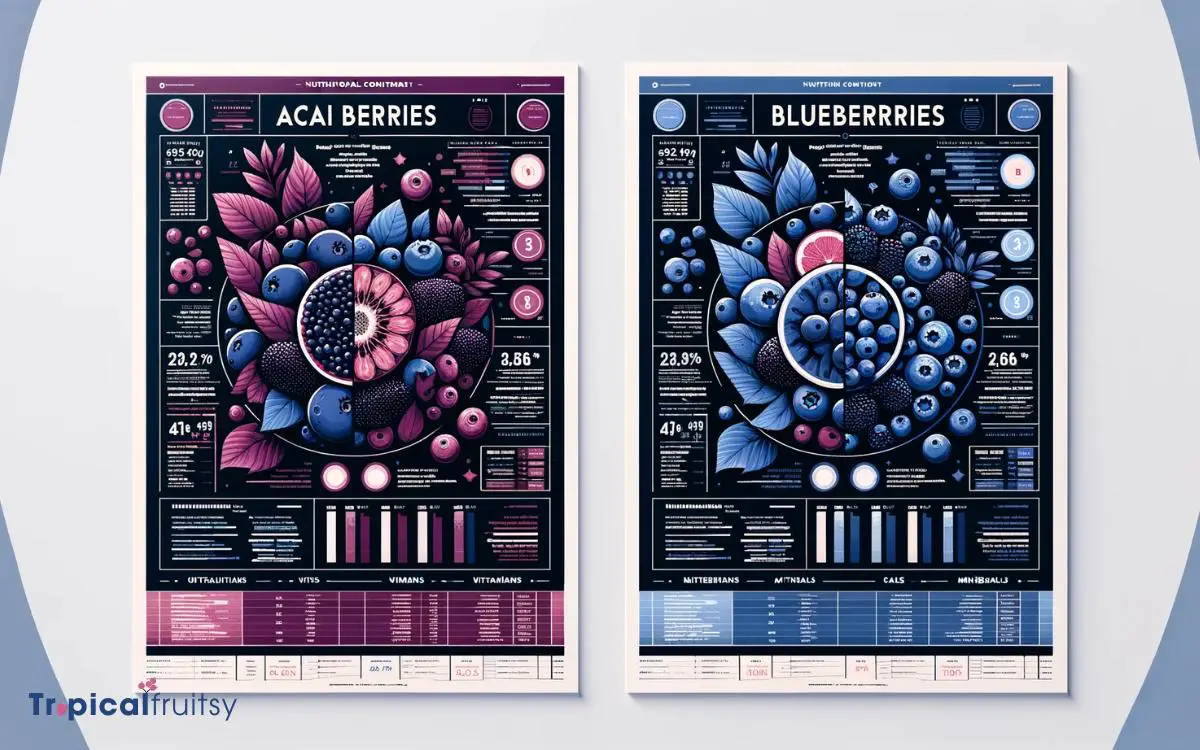Acai Berry and Blueberry Difference: You Need to Know!
Acai berries come from South American palm trees, are drupes, and have more antioxidants and healthy fats. Blueberries originate from North American plants, are true berries, and are rich in vitamins C and K.
Acai berries taste earthy, while blueberries are sweet and tangy. Different growing conditions impact availability and pricing.
Acai berries and blueberries differ fundamentally in their botanical classification, nutritional composition, and taste, which influences their use in various culinary contexts.
For instance:
Acai berries and blueberries cater to different nutritional needs and culinary preferences, enriching our diets with their unique benefits.

Key Takeaway
Comparison Between Acai Berry & Blueberry
| Attributes | Acai Berry | Blueberry |
|---|---|---|
| Scientific Name | Euterpe oleracea | Vaccinium spp. |
| Origin | Amazon rainforest, South America | Native to North America, now cultivated in many regions |
| Appearance | Small, round, dark purple to black | Small, round, deep blue to purple with a flared crown |
| Taste | Earthy, slightly tart with a hint of sweetness | Sweet with a slight tanginess |
| Nutrient Profile | Rich in antioxidants, fiber, heart-healthy fats | High in vitamin C & K, antioxidants, and dietary fiber |
| Health Benefits | Boosts brain function, aids weight loss, improves cholesterol | Antioxidant properties, heart health, supports brain function |
| Common Uses | Smoothies, bowls, juices, dietary supplements | Fresh consumption, pies, jams, juices, health supplements |
| Cultivation | Grows on acai palm trees | Grows on shrubs or bushes |
| Harvest Season | July-December in South America | April-August in North America |
| Storage | Best consumed fresh or frozen, pulp can be preserved | Fresh, frozen, dried, or preserved |
Origin and History

The acai berry originates from the rainforests of South America, while the blueberry is native to North America, with each fruit boasting a unique history tied to its region.
These small but mighty fruits hold not just nutritional value but also cultural significance. The acai berry, a staple in the Amazonian diet for centuries, was revered for its healing and energy-boosting properties. Indigenous tribes were the first to utilize the acai, both as a food source and in traditional medicine.
The blueberry has its roots in North America, where Native American tribes valued it for its sustenance and also recognized its medicinal qualities.
They used blueberries to treat ailments and preserve meat. Scientific studies have since corroborated the health benefits these berries offer, solidifying their place in modern diets.
Nutritional Content Comparison

Regarding nutritional content, acai berries and blueberries vary significantly in their profiles of vitamins, antioxidants, and dietary fiber.
Acai berries are particularly noted for their high content of antioxidants, especially anthocyanins, which are compounds that can help combat oxidative stress and may contribute to reducing the risk of chronic diseases. They are also rich in healthy fats like omega-9 and omega-6 fatty acids.
On the other hand, blueberries are renowned for their vitamin C and vitamin K content and have a high concentration of manganese. They also boast a substantial amount of dietary fiber per serving.
While both berries offer health benefits, the distinct differences in their nutritional make-up mean they can contribute to a balanced diet in diverse ways, supporting overall health and wellness.
Antioxidant Levels and Benefits

How do the antioxidant levels in acai berries compare to those in blueberries, and what health benefits might these differences confer?
Acai berries are renowned for their high antioxidant content, particularly anthocyanins and flavonoids, which are believed to be greater than those found in blueberries.
These potent compounds help neutralize free radicals, reducing oxidative stress and potentially lowering the risk of chronic diseases such as heart disease, cancer, and age-related cognitive decline.
Acai’s antioxidant profile is complemented by its omega fatty acids, fiber, and calcium, contributing to cardiovascular health and digestive well-being.
In contrast, blueberries, while also antioxidant-rich, offer a different blend of phytonutrients, including vitamin C and K, beneficial for immune support and bone health.
Transitioning from health benefits, the distinctive flavor profiles of acai and blueberry lead to their unique culinary applications.
Flavor and Culinary Uses
Distinguishing themselves through unique taste profiles, acai berries and blueberries each bring distinct flavors and versatility to culinary arts.
Acai berries offer a rich, earthy taste with hints of dark chocolate, making them a robust addition to smoothie bowls, energy bars, and supplements. Their flavor complements granola and yogurt, pairing well with other tropical fruits.

Blueberries, on the other hand, have a sweet and slightly tart profile, which shines in baked goods like muffins, pies, and pancakes.
They are also a popular choice for jams, jellies, and syrups due to their natural pectin content. Fresh or frozen, blueberries provide a burst of flavor in salads and cereals.
As we appreciate their culinary contributions, it’s important to consider the environments acai and blueberries require to thrive, which leads us to explore their growing conditions and availability.
Are Acai Berries and Blueberries Similar in their Cancer-Fighting Properties?
While acai berries and blueberries both offer a range of health benefits, research suggests that acai berries may possess stronger cancer-fighting properties. The unique combination of antioxidants and phytochemicals found in acai berries may contribute to their potential in preventing cancer. Further studies are needed to confirm acai berry cancer benefits.
Growing Conditions and Availability
Acai berries typically grow in the floodplain areas of the Amazon River, while blueberries are cultivated in various temperate regions around the world.

The distinct environments reflect the differing ecological needs of each berry, which in turn influences their global availability.
- Climate: Acai berries require a tropical, humid climate and are mostly found in the Amazon rainforest; blueberries thrive in acidic soil of temperate climates.
- Cultivation: Blueberries are widely cultivated on commercial farms, making them more globally accessible; acai berries are often harvested wild, which can limit their commercial availability.
- Harvesting Season: Blueberries have a specific harvesting season, usually from April to late September; acai berries can be harvested year-round due to the consistent tropical climate of the Amazon.
Understanding these growth conditions is crucial for consumers and producers alike, as they impact the fruit’s supply chain and market presence.
Conclusion
While the discerning health enthusiast may wage wars in the name of the superior berry, the subtle yet profound differences between acai and blueberry remain.
Each boasts a unique lineage, a cornucopia of nutrients, and a palette of culinary potential, though neither can claim absolute supremacy.
Amidst the battle of antioxidants and flavors, it becomes evident that nature’s bounty is not a competition but a diverse offering to the altar of well-being.






